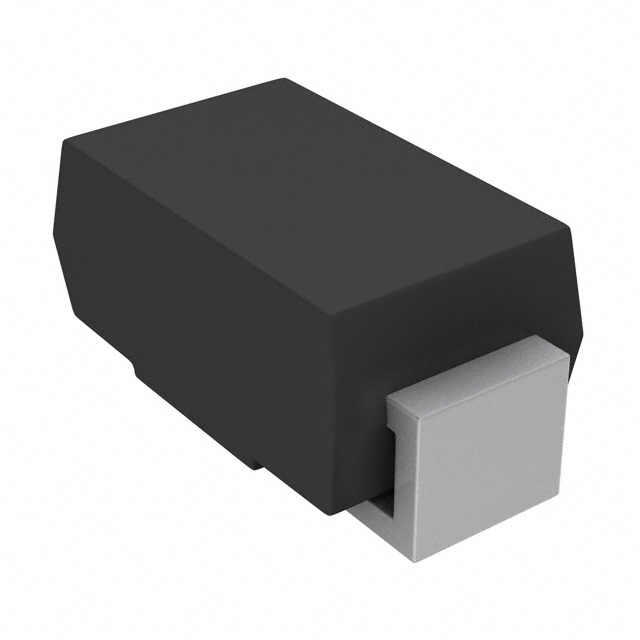Viz Specifikace pro podrobnosti o produktu.

BZG05B27-M3-18
Product Overview
Category
The BZG05B27-M3-18 belongs to the category of Zener diodes.
Use
It is primarily used for voltage regulation and protection in electronic circuits.
Characteristics
- Voltage regulation capability
- Reverse breakdown voltage of 27V
- Low leakage current
- High reliability
Package
The BZG05B27-M3-18 is typically available in a surface mount package.
Essence
The essence of this product lies in its ability to maintain a constant voltage across a circuit, thereby protecting sensitive components from voltage fluctuations.
Packaging/Quantity
It is commonly packaged in reels with quantities varying based on manufacturer specifications.
Specifications
- Reverse Breakdown Voltage: 27V
- Power Dissipation: 1.5W
- Zener Voltage Tolerance: ±5%
- Operating Temperature Range: -65°C to +175°C
- Forward Voltage: 1.2V
- Maximum Reverse Leakage Current: 5µA
Detailed Pin Configuration
The BZG05B27-M3-18 typically has two pins, with the anode connected to the positive terminal and the cathode connected to the negative terminal.
Functional Features
- Voltage regulation
- Overvoltage protection
- Stability in varying temperature conditions
Advantages
- Precise voltage regulation
- Protection against voltage spikes
- Wide operating temperature range
Disadvantages
- Limited power dissipation capability
- Higher cost compared to standard diodes
Working Principles
The BZG05B27-M3-18 operates based on the principle of the Zener effect, where it maintains a constant voltage drop across its terminals by allowing current to flow in reverse bias.
Detailed Application Field Plans
This Zener diode is commonly used in: - Voltage regulators - Overvoltage protection circuits - Power supplies - Electronic equipment requiring stable voltage levels
Detailed and Complete Alternative Models
- BZX84C27LT1G
- MMSZ5245BT1G
- 1N5227B
In conclusion, the BZG05B27-M3-18 Zener diode offers precise voltage regulation and overvoltage protection, making it suitable for various electronic applications. While it has limitations in power dissipation and cost, its reliability and stability make it a preferred choice in many circuits. Additionally, alternative models such as the BZX84C27LT1G, MMSZ5245BT1G, and 1N5227B provide similar functionality for different design considerations.
Seznam 10 běžných otázek a odpovědí souvisejících s aplikací BZG05B27-M3-18 v technických řešeních
What is the BZG05B27-M3-18?
- The BZG05B27-M3-18 is a Zener diode with a voltage of 27V and a power rating of 500mW.
What are the typical applications of BZG05B27-M3-18?
- It is commonly used in voltage regulation, overvoltage protection, and surge suppression in various electronic circuits.
What is the maximum current that BZG05B27-M3-18 can handle?
- The maximum current for BZG05B27-M3-18 is typically around 20mA.
How does BZG05B27-M3-18 provide overvoltage protection?
- When the voltage across the diode exceeds its breakdown voltage (27V), it conducts heavily, diverting excess current and protecting the circuit downstream.
Can BZG05B27-M3-18 be used in reverse bias?
- Yes, it can be used in reverse bias as a voltage reference or as a protection device against negative voltage spikes.
What are the temperature specifications for BZG05B27-M3-18?
- The operating temperature range is typically from -65°C to +175°C.
Is BZG05B27-M3-18 RoHS compliant?
- Yes, it is compliant with the Restriction of Hazardous Substances (RoHS) directive.
What is the package type for BZG05B27-M3-18?
- It is available in a SOD-123FL package, which is a surface-mount package.
Can BZG05B27-M3-18 be used in high-frequency applications?
- Yes, it can be used in high-frequency applications due to its fast response time and low capacitance.
Are there any recommended layout considerations when using BZG05B27-M3-18?
- It is recommended to minimize the length of the traces connected to the diode and to place it close to the protected circuit to reduce parasitic inductance and ensure effective protection.

